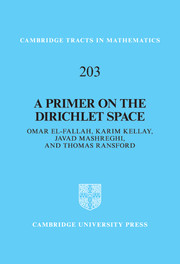Book contents
- Frontmatter
- Dedication
- Contents
- Preface
- 1 Basic notions
- 2 Capacity
- 3 Boundary behavior
- 4 Zero sets
- 5 Multipliers
- 6 Conformal invariance
- 7 Harmonically weighted Dirichlet spaces
- 8 Invariant subspaces
- 9 Cyclicity
- Appendix A Hardy spaces
- Appendix B The Hardy–Littlewood maximal function
- Appendix C Positive definite matrices
- Appendix D Regularization and the rising-sun lemma
- References
- Index of notation
- Index
Preface
Published online by Cambridge University Press: 05 January 2014
- Frontmatter
- Dedication
- Contents
- Preface
- 1 Basic notions
- 2 Capacity
- 3 Boundary behavior
- 4 Zero sets
- 5 Multipliers
- 6 Conformal invariance
- 7 Harmonically weighted Dirichlet spaces
- 8 Invariant subspaces
- 9 Cyclicity
- Appendix A Hardy spaces
- Appendix B The Hardy–Littlewood maximal function
- Appendix C Positive definite matrices
- Appendix D Regularization and the rising-sun lemma
- References
- Index of notation
- Index
Summary
The three classical Hilbert spaces of holomorphic functions in the unit disk are the Hardy, Bergman and Dirichlet spaces. There are several excellent texts covering the Hardy space and the Bergman space. However, to the best of our knowledge, up to now there has been no book devoted to the Dirichlet space. When we began our respective researches into the Dirichlet space, we found ourselves handicapped by the fact that the necessary background information was scattered around the literature, sometimes contained in articles that were difficult to follow. For this reason we began to think about writing an introduction that would be suitable for researchers and graduate students seeking a solid background in the subject. The more we learned about this topic, the more we became convinced that it contains many beautiful ideas that deserve a systematic exposition.
The name Dirichlet space derives from its definition in terms of the so-called Dirichlet integral, arising in Dirichlet's method for solving Laplace's equation (sometimes called the Dirichlet principle). As far as we can determine, the first appearance of the Dirichlet space under that name dates back to two articles of Beurling and Deny in 1958 and 1959, but in fact the notion existed and had been studied at least since Beurling's thesis, which was published in 1933 and written even a little earlier. In the years that followed, Beurling and Carleson laid the foundations of the theory and, after their pioneering work, many other distinguished mathematicians made important contributions.
Information
- Type
- Chapter
- Information
- A Primer on the Dirichlet Space , pp. xi - xivPublisher: Cambridge University PressPrint publication year: 2014
